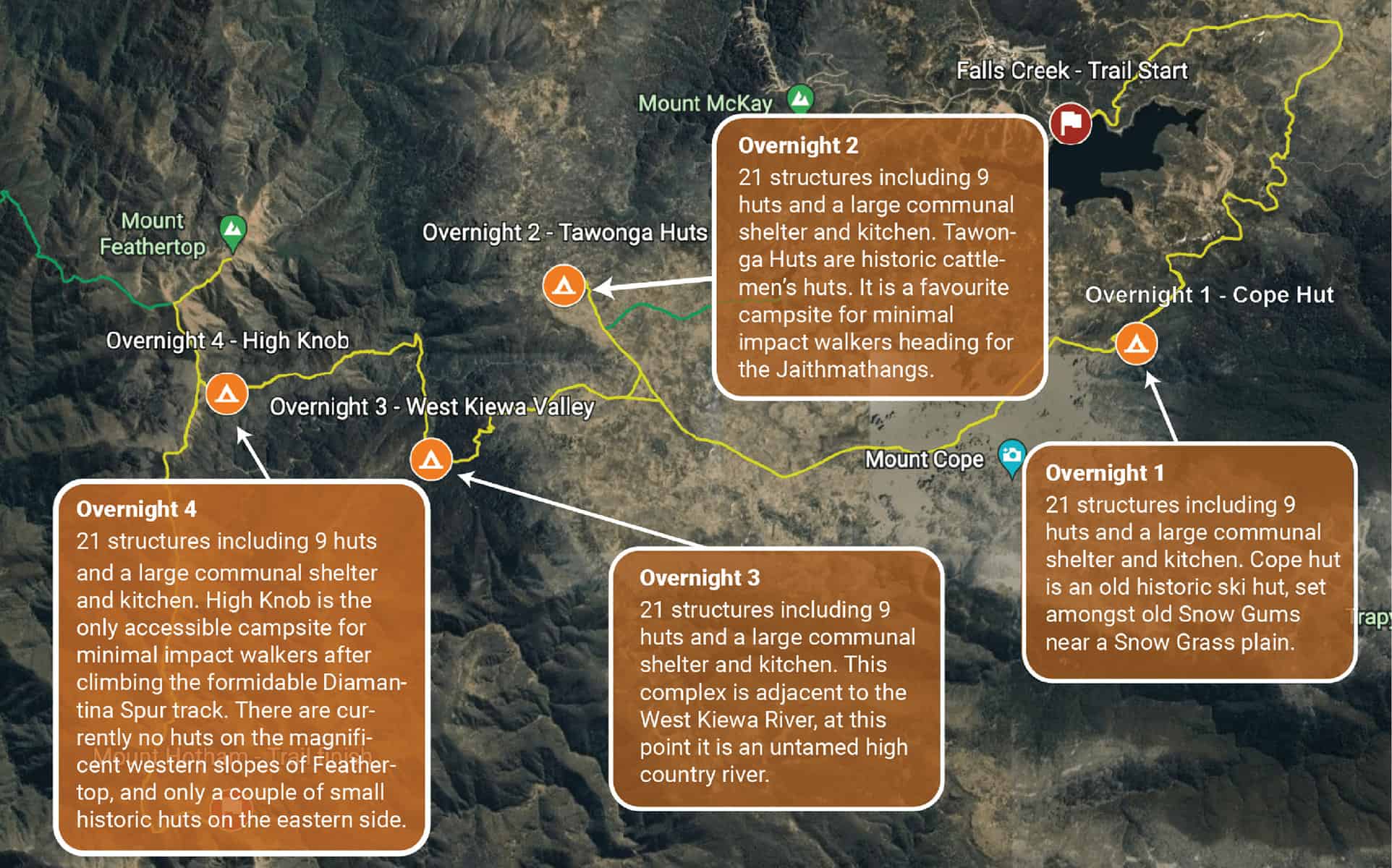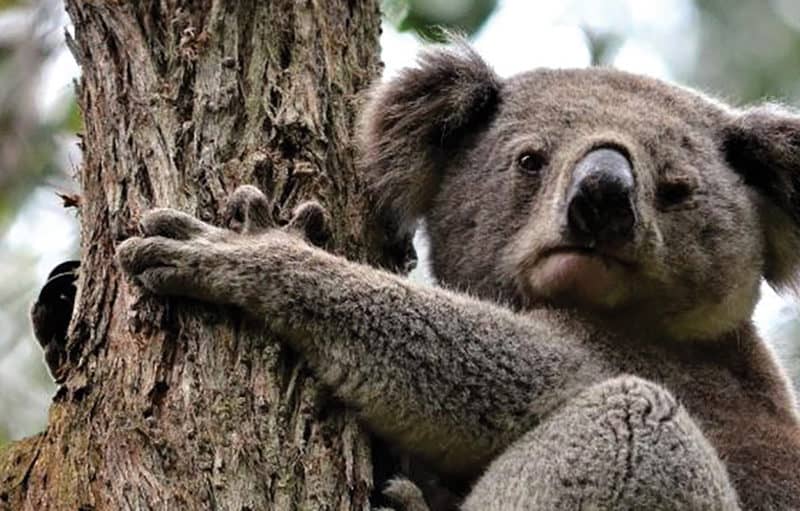PARK WATCH Article November 2022 |
Parks Victoria’s flawed scheme for the Falls to Hotham Alpine Crossing flows from its fumbling lack of clarity over how and why our national parks should be managed, says former Parks Protection Advocate Phil Ingamells.
The proposal to build around 80 commercial structures in the core of Victoria’s Alpine National Park should have been knocked off at the first hurdle. That an initial stage has actually been funded by government to the tune of $11 million is outrageous.
The alpine region of south-eastern Australia seems large, but it’s actually a tiny percentage of the continent, and protects a vast range of specialised plants and animals highly vulnerable to climate impacts and other threats.
Since its formation in 1952, VNPA has been fighting hard for protection of Victoria’s precious high country. That effort has included campaigning to end logging and cattle grazing, avoid unnecessary infrastructure and, most critically, winning legislated conservation protection for the bulk of Victoria’s alpine region in national parks.
The Alpine National Park is one of Victoria’s most important protected areas; it is one of very few also awarded National Heritage status. That listing speaks strongly of the importance of Australia’s alpine parks, as “… one of the most important areas in the southern half of Australia for endemism and species richness”. The listing also notes that the “powerful, aesthetic inspirational qualities of the landscape … have been recognised over a long period of time”.
The heritage listing specifically draws attention to Victoria’s magnificent Mt Feathertop and the sublime moss-bedded Bogong High Plains in this regard, both of which will be significantly impacted by Parks Victoria’s development proposal.
What exactly is the Falls to Hotham Alpine Crossing (FHAC)?
An overnight adventure trek across the southern Bogong High Plains, between the Falls Creek and Hotham alpine resorts, has been popular with minimal-impact bushwalkers for many years. It’s usually achieved in a couple of days.
Tourism interests now want to ‘upgrade’ that experience, and have proposed a five-day walk featuring four commercially operated accommodation ‘hubs’ along the way. Existing tracks will be widened, and new tracks constructed. The walk will also be diverted up the steep and treacherous Diamantina Spur Track to take in views from Mt Feathertop.
The four new overnight accommodation hubs will each feature up to nine catered huts for 2-3 people, a dozen rentable tent platforms, a separate large building (for 50-80 people!) for group gatherings and meal preparation, as well as communal toilets and additional accommodation for tourism operators. These hubs will be constructed near the historic Cope and Tawonga Huts on the Bogong High Plains, on the Diamantina River at the base of Mount Feathertop, and at the remote High Knob near Feathertop’s imposing summit.
According to Parks Victoria’s Preliminary Environmental Assessment, the impact zone of this government-funded development will total around 45 hectares, equal to 22 times the area of the MCG oval.
It is a massive imposition of tourist infrastructure on the park and runs contrary to the far more enlightened park management practices emerging around the world. Park managers in the USA, for example, are removing troublesome infrastructure from parks such as Yosemite as visitor pressures and other management problems grow.
Why is the State Government funding this scheme?
It’s a good question!
It has been Victorian Government policy for several years now that “tourism development will be encouraged to be sited on private or other public land outside national parks”, a policy that was recently reaffirmed on the floor of our parliament.
Importantly, when Bogong National Park was proclaimed in 1981, the park boundary carefully excluded both the Falls Creek and Hotham Alpine Resorts. The idea was to constrain future developments to those areas, leaving the national park free from development pressures. Less than a decade later, when Bogong was absorbed into a larger Alpine National Park, those strategic borders remained in place.
And when the 650 km Australian Alps Walking Track (AAWT), from Walhalla in Victoria to the ACT, was developed in the 1970s and 80s, the promise was made that this would not mean the introduction of built accommodation to the remote areas the track traversed.
Indeed, the recent Australian Alps Walking Track Strategy 2021-2025, agreed to by the park agencies of Victoria, NSW and the ACT, re-affirms that policy by saying “track users are expected to be self-sufficient” and “not reliant on huts for shelter”. It adds that “walkers often choose to make use of commercial accommodation at resort areas or nearby settlements along the AAWT”.
It seems over-enthusiastic tourism idealogues (some inside and some outside government) have ignored these long-standing policy positions, to stake their claim on a prime piece of public real estate in one of our state’s most precious natural areas.
What about equity of access to national parks?
Despite the fact that tourism statistics show that national parks already contribute substantially to tourism (they generate far, far more for regional economies than they cost to run), and though the overwhelming majority of park visitors are seeking day or half-day walks, the pressure has been on to develop ‘icon’ multi-day walks for the ‘comfort-in-nature’ tourist.
The claim is made that national parks should not just be available to people who want to carry a pack and sleep in a tent. But pretty much anywhere on the proposed FHAC route can be accessed as a day or part day walk from either the Falls Creek or Hotham alpine resorts. Each resort boasts a wide range of comfortable to luxury accommodation that is largely unoccupied throughout the summer months.
The FHAC proposal would swing the balance almost entirely in favour of the luxury traveller, as the long-favoured campsites of self-sufficient hikers would be replaced with a complex of huts, offered at a rate somewhere between $440 and $1,000 per person per night.
How do these schemes get credibility?
Despite Victorian Government policy to keep commercial developments out of parks, despite the crystal-clear objective of our National Parks Act for park managers to focus on biodiversity priorities, and despite federal law and the international Convention on Biological Diversity mandating that same priority, Parks Victoria repeatedly falls easy prey to half-baked schemes for unnecessarily invasive tourist developments in our parks.
Take the locally generated development proposals for Mt Buffalo National Park a few years back: construction of a spa bath and hotel, shopping mall, roller-skating rink and wedding chapel actually won project development funding from Tourism Victoria. Bizarrely, the local Alpine Shire, which has no management responsibility for the park, was entrusted with evaluating the scheme.
More recently, Yarra Ranges Shire grabbed federal funding for a mega bike track threatening many rare plants and animals as well as cool temperate rainforests in Yarra Ranges National Park, even though (here we go again) it has no responsibility or accountability for the management of any national park.
What’s needed?
The Environment Minister must ask Parks Victoria to establish a clear box-ticking process for consideration of any tourism-related endeavours in our national parks and other conservation reserves, consistent with legislation and current government policy. Anyone proposing developments should be well-informed at the outset that developments should be adjacent to, rather than within, national parks.
This would encourage planning certainty for private and/or government proponents, and provide clarity to any organisation approached to fund projects. It would save vast amounts of time and money for developers, funding bodies, the general public and Parks Victoria itself.
Well-defined and well-understood clarity in this regard will enable long-standing protection for our remaining natural areas. This is how we make sure all of us will be able to enjoy them, at their best, for generations to come.
Parks Victoria’s public consultation has been a sham
Some six years ago, when the public was first asked to comment on the Falls to Hotham Alpine Crossing, nearly 90 per cent of submissions were opposed to the construction of huts and lodges in the park. But that response was misrepresented by Parks Victoria, which claimed the proposal had broad public support.
Parks Victoria has never publicly corrected that false claim, an outrageous situation for a government agency charged with investing public money on high conservation value public land.Around five years ago, a report into Public Participation in Government Decision-Making by the Office of Victoria’s Auditor-General (VAGO) made it clear that: “It is important to recognise that public participation is not the same as public relations or communications, which have the objectives of maintaining a favourable image.”
VAGO added that public participation “is based on the belief that those who are affected by a decision have a right to be involved in the decision-making process”.
And importantly, VAGO mandated that the public be provided with “the information they need to participate in a meaningful way”.
In the current public consultation process for the Falls to Hotham Alpine Crossing, Parks Victoria has failed this last criterion miserably:
- The Preliminary Environmental Effects Statement is an indigestible 233 pages long, with no objective summary of impacts.
- The Landscape and Visual Impact Assessment study is misleading, with all visual impacts assessed from several kilometres away from proposed development sites.
- The Business Case is a highly redacted document, and makes no comparative assessment of less impactful options.
- It is silent on important processes like Traditional Owner consultation.
- The questions addressed to the public on the Engage Victoria website are trivial, and based on the assumption that the project already has strong public approval. There is no invitation to comment on the project as a whole.
It’s time the government and Parks Victoria injected some integrity into public engagement in the management our most precious protected areas.
Image: Mark Darragh
Did you like reading this article? You can read the latest full edition of Park Watch magazine online.
Want to be kept up to date about this and other nature issues in Victoria? Subscribe to our email updates.
You can also receive our print magazine Park Watch four times a year by becoming a member. Find out more.

